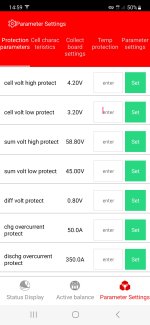I believe it’s the chargers responsibility to stop the charge at the desired maximum voltage that the pack considers a full charge.
Well, yes, but the charger still doesn't require any smarts for this. All it needs is to be a normal charger that is set to the correct final charge voltage, and has the correct termination-current so that when current drops below that threshold, it shuts off when both conditions are met. Most common Lithium-battery chargers (for ebikes, etc) do this.****
But the charger itself can't tell if a cell is overcharged, etc.; the BMS has to do this. ******
If the charger and BMS are in communication of some form (even an enable/disable line) then the BMS can tell the charger to stop, and some systems do this...but only ones that are integrated together, and for those you have to use the specific charger / BMS pair designed to work together (or be ready for some potentialy serious DIY).
But otherwise the BMS has to break the connection between charger and pack when any limit is exceeded.
only problem is that I can't use it because its not CE certified.
I would bet you that the Daly is not, either. Do they list a traceable certification document you can go look up at a central CE authority?
Many parts and systems of many kinds these days are marked with certifications they do not have because it means someone will buy them that way when otherwise they would not have.
Marketing...



With the BMS to act as a safety to keep the battery pack from overcharging.
You never want to depend on a safety for control.
Mainly thinking of typical non-programmable BMS’ here…
True, but...in these minimalistic cheap systems, it's almost unavoidable without adding expense and complexity and more DIY for the end-user, many (most?) of whom are not willing, qualified or capable of safely doing the work and making sure it's doing the job it needs to do. :/
I can't understand how a 14s pack @ 48 volt nominal can be in such a high voltage charge range...

These two don't seem to fit together. Battery chemistry?
I don't see any excessive voltages listed in this thread for the OP's pack?
A 14s pack should be about 52v nominal, typically, assuming a non-LiFePO4 chemistry. (13s is typically around 48v nominal).
The 14s pack typically charges up to around 58v, depending on the final max charge voltage of the cells (some are 4.2, some 4.15, etc).
The 12s pack typically charges to around 54v.
**** There are some chargers that do not have a shutoff current but instead just a max voltage; they're not as "safe" to use if the BMS doesn't do it's job.
Some have a shutoff current too, but a latch that keeps it off afterward until disconnected/reconnected or even power cycled, and this used to be so common with LiFePO4 chargers that it was a common design to have a little board installed on the LFP chargers that latched the output off once max voltage was reached. But some packs wouldn't balance because of this, so you could break the little board off and remove the latching, so that it would operate just like the non-LFP chargers that allowed normal balancing where the pack cuts off input so charger shuts down, then pack reallows input and charger starts again, etc.
****** This excludes systems like RC chargers that actually connect to every cell and monitor them directly, but most systems using those don't use a BMS at all.
 I think the problem lies in the BMS settings because I have another BMS and I don't have any problems when i use that one, only problem is that I can't use it because its not CE certified. I haven't enabled regen in controller settings so it shouldn't be overcharge protect but I can't think of another explanation. Any good ideas?
I think the problem lies in the BMS settings because I have another BMS and I don't have any problems when i use that one, only problem is that I can't use it because its not CE certified. I haven't enabled regen in controller settings so it shouldn't be overcharge protect but I can't think of another explanation. Any good ideas?

